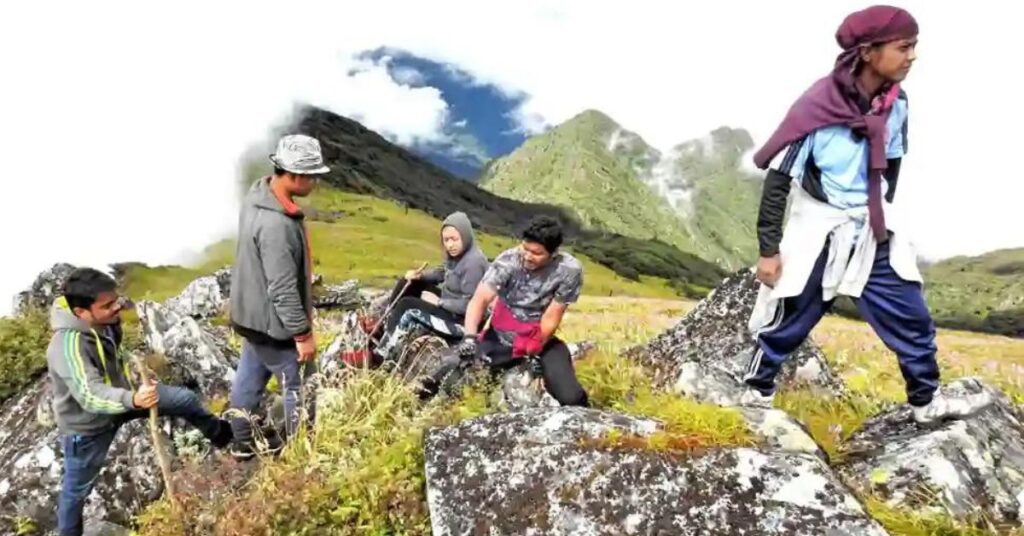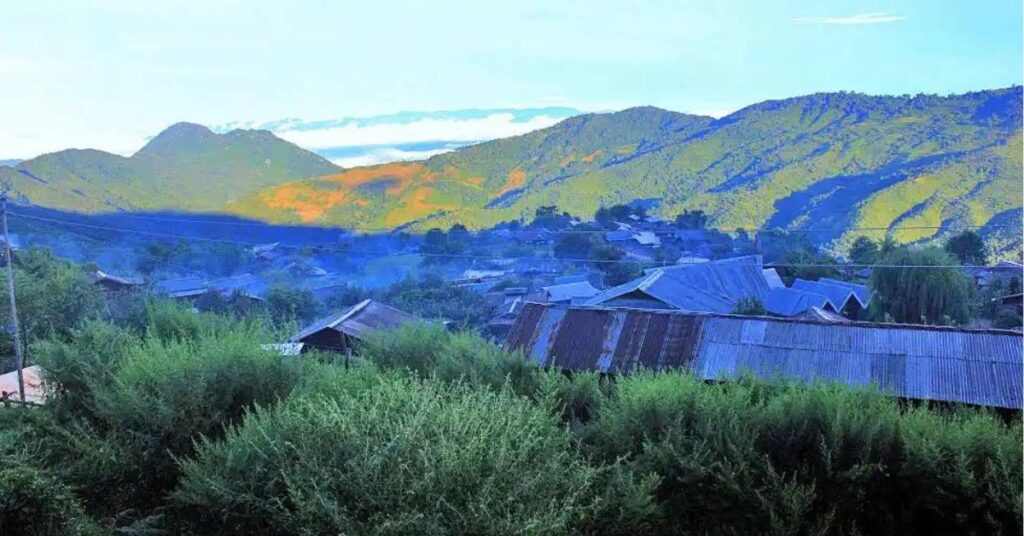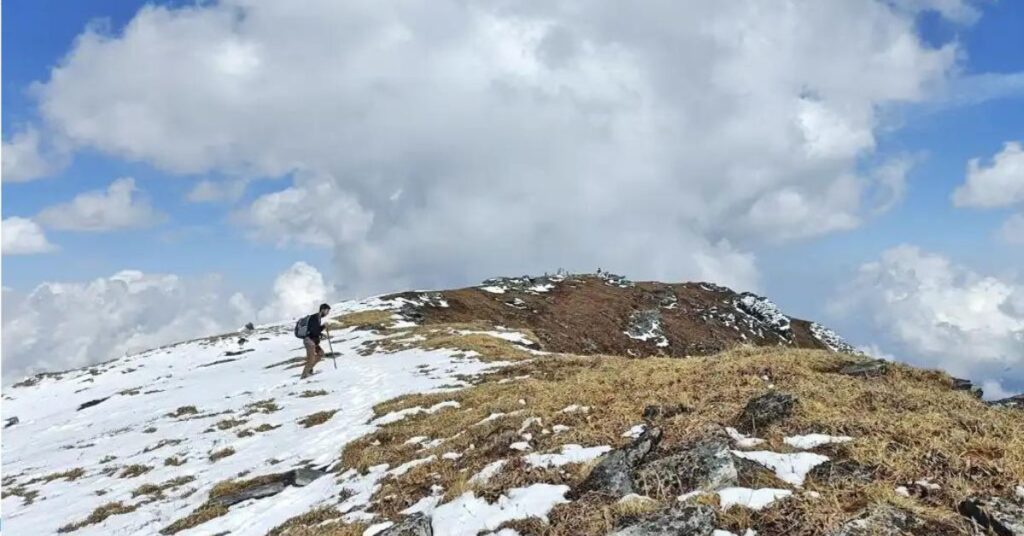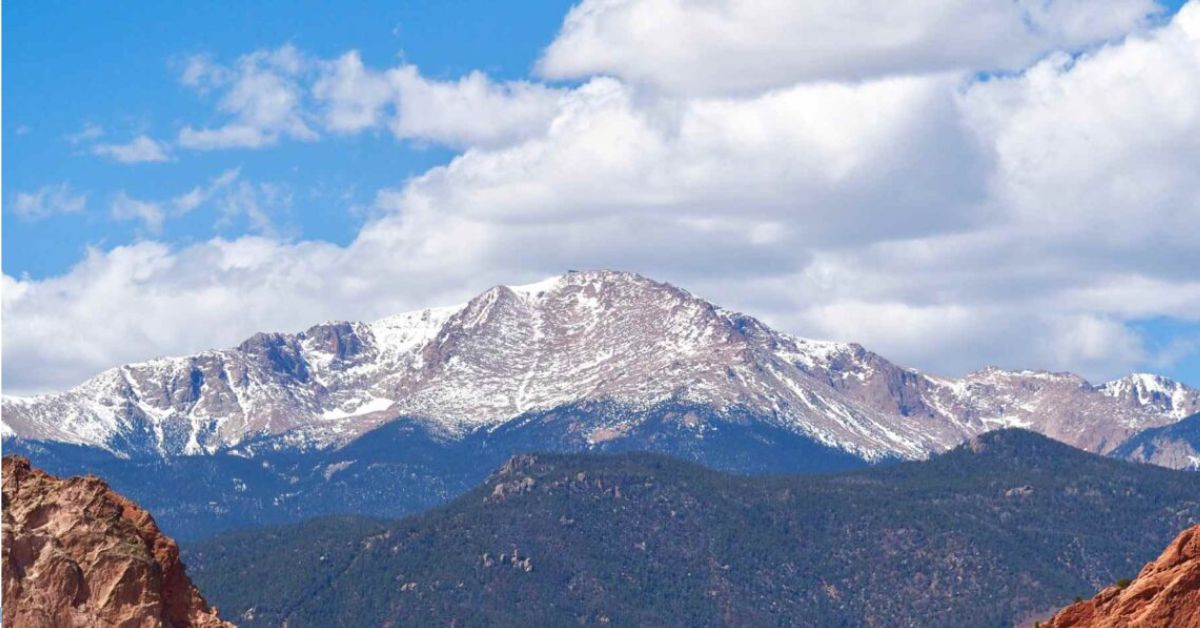Calling all adventure seekers! Get ready to conquer Nagaland’s tallest mountain – the mighty Saramati Peak! This isn’t just any mountain; it’s a whopping 3,826 meters tall and tucked away in the remote Kiphire district.
The trek to Saramati Peak is like stepping into a real-life adventure movie. Imagine thick forests teeming with life, rocky paths leading to high viewpoints, and endless mountain ranges stretching as far as the eye can see. The trails wind through different kinds of landscapes, keeping things exciting – from lush jungles to rocky climbs. You might even spot some rare plants and animals along the way!
How to reach:
Flying High:
Your journey to conquer Saramati Peak starts in Dimapur, Nagaland’s biggest city. Luckily, Dimapur Airport has connections to major Indian cities like Kolkata, Guwahati, and Imphal. Once you land, taxis and other local rides can whisk you towards Kiphire, the gateway town to your mountain adventure.
Train Option:
Dimapur also has a train station with connections to Guwahati and Kolkata. If trains are your thing, you can use this option to reach Dimapur and then continue by road to Kiphire.
Reaching Kiphire:
Kiphire, the town that unlocks your Saramati Peak adventure, sits about 150 kilometers away from Dimapur. Most travelers hire taxis or use private vehicles for this leg of the journey. The road trip can take anywhere from 4 to 6 hours, depending on the road conditions. Since the roads can be a bit rough, make sure your vehicle is in tip-top shape before you hit the gas!
Best time to visit:
Winter Wonderland (December to February):
- Weather: Brace yourself for cool to chilly days (5°C to 15°C) and freezing nights, especially at higher elevations. Snow might blanket the peak, creating a magical winter scene.
- Pros: Crystal-clear skies offer stunning views, and the crisp air makes trekking enjoyable. The snow-capped mountains are a sight to behold!
- Cons: Be prepared for the cold and potential snow on the trails, which can make trekking more challenging. Pack proper winter gear!
Spring Awakening (March to May):
- Weather: Temperatures gradually rise (10°C to 20°C) with cooler nights. Generally dry and clear, making it a great time to trek.
- Pros: Spring brings pleasant temperatures, minimal rain, and good visibility. Blooming flowers add a pop of color to the landscape.
- Cons: The monsoon season can creep in by late May, so check the forecast and be prepared for potential rain showers.
Monsoon Magic (June to September):
- Weather: Expect heavy rain, frequent showers, and high humidity. Temperatures range from 15°C to 25°C, but the trails can become slippery and challenging.
- Pros: The region transforms into a lush paradise with vibrant green vegetation.
- Cons: Trekking during the monsoon is difficult due to wet and potentially dangerous trails. Monsoon is the least ideal time for trekking Saramati Peak.
Autumn Adventure (October to November):
- Weather: Cooler temperatures (10°C to 20°C) return with clear and dry conditions, making it perfect for trekking.
- Pros: Enjoy clear skies, excellent visibility, and manageable trails. This is also festival season, offering a chance to experience local culture.
- Cons: Peak season means booking accommodations and guides in advance is essential.
Attraction:
Scenic Trekking Trails:

The trek to Saramati Peak is like stepping into a postcard come to life! The trails wind through a crazy mix of landscapes, keeping things exciting the whole way. Imagine starting at the base camp, surrounded by thick forests with towering trees and colorful plants peeking out from below.
As you climb, the paths change, leading you through wildflower meadows that look like a giant paintbrush has splattered color everywhere. There might even be some rocky climbs that reward you with epic views of the whole area. From peaceful bamboo forests to rocky, high-altitude sections, each part of the trek shows off a different side of Nagaland’s amazing nature.
Local Villages and Culture:

The trek to Saramati Peak isn’t just about the mountain itself. Along the way, you’ll have the chance to explore traditional Naga villages nestled in the Kiphire district. These villages, home to the Kuki and Ao Naga tribes, offer a fascinating peek into the region’s rich cultural heritage. Imagine meeting the villagers and seeing their way of life firsthand. You might see them weaving beautiful textiles, using age-old farming techniques, or sharing stories about the land and its traditions. Their warm hospitality adds another layer to the experience.
High-Altitude Adventure:

The trek to Saramati Peak isn’t for the faint of heart. It’s a high-altitude challenge that mixes physical exertion with jaw-dropping rewards. Get ready to tackle rugged terrain – think steep climbs and rocky paths – that will test your stamina and sense of adventure. As you climb through Nagaland’s diverse landscapes, each step feels like a victory. The tougher the challenge, the sweeter the reward! Reaching the peak isn’t just about the breathtaking panoramic views, it’s a feeling of accomplishment you won’t forget. The combination of high altitude and challenging trails makes this an epic adventure for those who crave a physical push and the thrill of exploring one of Nagaland’s most remote and beautiful spots.
local experiences:
Village Encounters: Explore nearby villages inhabited by the Kuki and Ao Naga tribes. Witness their traditional way of life, from intricate weaving and pottery to age-old farming practices. Gain a deeper understanding of their customs and everyday routines.
Festival Flair: Time your trip right and immerse yourself in vibrant local festivals like Tokhu Emong. Witness electrifying dances, captivating music, and traditional ceremonies that showcase the heart of Naga culture.
A Taste of Nagaland: Tantalize your taste buds with authentic Naga cuisine. Savor dishes like smoked meats, bamboo shoot curries, and spicy vegetable stews prepared using local ingredients and traditional cooking methods.
Cultural Treasures: Discover the unique heritage of the region through handcrafted textiles, jewelry, and artifacts created by local artisans. Take home a piece of Nagaland’s cultural tapestry!
Melodies and Movement: Immerse yourself in the rhythmic beats of traditional Naga music and dance. Catch captivating performances during festivals or village gatherings and gain a glimpse into the region’s rich artistic expression.
Live Like a Local: Opt for a homestay experience and truly connect with the Naga way of life. Live alongside local families, participate in daily activities, and gain a deeper understanding of their culture from the inside out.
Expert Insights: Hire local guides for a more enriching experience. They can share their knowledge of the region’s history, culture, and natural environment, bringing the trek to life.
Hands-on Learning: Participate in workshops or demonstrations of traditional skills like weaving or crafting. Get a firsthand appreciation for Naga cultural practices and learn from the masters themselves.
Spiritual Significance: Explore sacred sites and delve into the myths and legends surrounding Saramati Peak, a significant part of the Naga communities’ spiritual life.
Market Marvels: Explore bustling local markets in Kiphire and nearby villages. Immerse yourself in the vibrant trading atmosphere and discover unique local produce, handcrafted souvenirs, and hidden treasures.
From Field to Table: Observe and perhaps even assist with traditional farming techniques used by local communities. Gain a unique perspective on rural life and agriculture in Nagaland.
Nature’s Wonders: Embark on birdwatching and wildlife spotting expeditions along the trek. Discover the region’s rich biodiversity and learn about the ecological significance of the area from local experts.
travel tips:
Permits: Secure your Inner Line Permit (ILP) online or visit designated offices in major Indian cities before your trip.
Acclimatize: Spend a few days in Kiphire (or nearby) to adjust to the higher altitude and avoid altitude sickness.
Local Guides: Hire a local guide or agency for a safe and organized trek. They’ll be your experts on the trails and local culture.
Pack Smart: Layers for changing temperatures, rain gear, and sturdy boots are essential.
Fuel Your Hike: Bring enough water and high-energy snacks. Don’t rely on finding water sources along the way.
Respect the Culture: Be mindful of local customs and traditions. Always ask permission before taking photos of people or sacred sites.
Trail Updates: Check current trail conditions and weather forecasts before you start your trek. Local guides or agencies can provide the latest information.
Pack Light: Opt for lightweight and compact gear – sleeping bag, trekking poles, first-aid kit, headlamp/flashlight.
Leave No Trace: Pack out all your trash, avoid disturbing wildlife, and stick to designated trails to minimize your impact.
Be Prepared: Carry basic medications and a first-aid kit. Ensure your health insurance covers high-altitude trekking.
Book Ahead: Arrange your accommodations and permits well in advance, especially during peak season.
Emergency Contacts: Keep a list of emergency contacts (local authorities and trekking agency) in case of unforeseen situations.
conclusion
Unveiling the magic of Nagaland’s crown jewel, Saramati Peak, this trek is a dream come true for nature enthusiasts and culture seekers. Embark on a challenging yet rewarding journey that winds through diverse landscapes, from lush forests teeming with life to rugged highlands that will test your limits. As you conquer each step, you’ll be rewarded with breathtaking panoramic views that stretch as far as the eye can see. But the magic extends far beyond the summit. Along the scenic trails, encounter a rich tapestry of flora and fauna, and delve into the vibrant traditions of local Naga communities. Their age-old customs and captivating way of life add depth and meaning to your experience. The peak itself holds significant spiritual importance, enriching the trek’s cultural tapestry with stories and legends woven through time. To fully appreciate the stunning vistas, the profound sense of achievement, and the unique cultural encounters that Saramati Peak offers, plan your unforgettable journey with Xplro.com, your trusted travel companion. We’ll handle the logistics, from selecting the perfect season to securing permits, booking accommodations, and connecting you with expert local guides. Let Xplro.com help you conquer Nagaland’s crown jewel and focus on creating lasting memories on your Saramati Peak adventure.
faqs
1. What is Saramati Peak?
- Saramati Peak is the highest mountain in Nagaland, rising to an elevation of 3,826 meters (12,552 feet). It is situated along the India-Myanmar border within the Patkai Range and is renowned for its stunning panoramic views and trekking opportunities.
2. How can I reach Saramati Peak?
- To visit Saramati Peak, travel first to Kiphire, a town in Nagaland. From Kiphire, you can start the trek or arrange local transportation with guides. The nearest major airport is in Dimapur, which is accessible by road from Kiphire.
3. When is the ideal time to visit Saramati Peak?
- The ideal time to trek to Saramati Peak is from October to April, when the weather is dry and cool, providing clear views and comfortable trekking conditions. The monsoon season, from June to September, is best avoided due to heavy rains and potential trail hazards.
4. Is a permit required for visiting Saramati Peak?
- Yes, visitors need an Inner Line Permit (ILP) to travel to Nagaland and Saramati Peak. This permit can be obtained through online applications or at Indian embassies and consulates and is mandatory for non-Naga Indian travelers.
5. How difficult is the trek to Saramati Peak?
- The trek to Saramati Peak is considered moderately challenging. It involves navigating through rugged terrain and varying altitudes, demanding good physical fitness and proper preparation. The trek can be demanding, so it’s essential to be prepared for its physical aspects.
6. What should I bring for the trek?
- Pack essential gear including warm clothing for changing temperatures, waterproof outer layers, durable trekking boots, a sleeping bag, trekking poles, a first-aid kit, and energy-rich snacks. It’s also important to carry sufficient water for hydration.
7. Are there places to stay near Saramati Peak?
- Accommodation options are available in Kiphire, the town closest to Saramati Peak. Choices range from basic guesthouses to more comfortable lodges. Depending on your trekking route and the season, you may need to camp or use simple shelters along the way.
8. What wildlife might I encounter on the trek?
- The trek to Saramati Peak offers opportunities to observe diverse wildlife, including rare bird species like the Blyth’s Tragopan. The area is rich in biodiversity, providing chances to see various mammals, insects, and unique plant life.
9. Is trekking to Saramati Peak safe?
- The trek is generally safe with proper precautions. It is advisable to hire experienced local guides, adhere to safety recommendations, and ensure you’re physically prepared. Make sure to have all necessary permits and follow safety protocols.
10. Can I get a guide for the trek?
- Yes, hiring a local guide is highly beneficial. Local guides offer valuable knowledge about the terrain, weather conditions, and cultural insights, ensuring a safer and more informed trekking experience.
11. What cultural norms should I follow?
- Respect local customs and traditions during your visit. Ask for permission before taking photographs of people or sacred sites. Being respectful of local practices and participating in local festivals can greatly enhance your travel experience.
12. What should I do in case of an emergency while trekking?
- In emergencies, promptly contact your guide or trekking agency. Maintain a list of emergency contacts, including local authorities and medical facilities. Carry a first-aid kit and ensure you have travel insurance that covers trekking activities for added safety.






